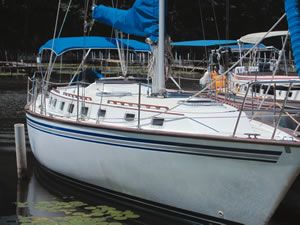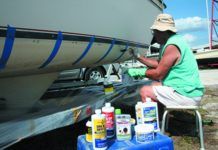
I bought the Perfect Home dehumidifier based on your October 2014 report. You mentioned that you bypassed the converter to use 4 amps at 12 volts; how did you do that? Is there a cord or something that I can buy?
Bob Turk,
Northwind II, 38-foot Endeavour,
Point Breeze, Kent, N.Y.
One would think 18 months of rigorous testing would be long enough to reveal any problems in a dehumidifier. It wasnt. To our chagrin, the Perfect Home test unit died just one month after our October report recommended it. The plugs wore loose, the fan bearing seized, the cold plate no longer cooled, and the power supply began running hot. We still recommend the EvaDry 2200, which has served us flawlessly for more than two years. The EvaDry offers an optional 12-volt cigarette light plug, but we suggest a more permanent 12-volt marine connector. (Remember to keep the circuit protected by a correctly sized fuse and/or breaker.)
If you decide to keep the Perfect Home, which has a DC motor, wiring for 12-volt is pretty simple. On our test unit, we used a discarded connector that we had lying around-pretty sure it was from a dead spotlight. Ancor (www.ancorproducts.com) makes some inexpensive heat-shrink snap plugs that weve used before. There are also more expensive waterproof/dustproof plugs from Hella (www.hellausa.com), Cole Hersee (www.colehersee.com), Blue Sea (www.bluesea.com), and Bulgin (www.bulgin.co.uk/usa).
Before you switch to 12-volt, though, there are a few good reasons to simply use an inverter and operate on 120 volts instead. By operating on 120 volts, you can use an inexpensive receptacle photosensor or clock timer to turn the units on and off while youre away. These dehumidifiers need to be turned off a few hours each day to defrost. Running the dehumidifier on our test boat, a 32-foot catamaran, for four to eight hours per day is enough to keep the relative humidity below 60 percent. Also, most inverters like those from Promariner (www.promariner.com), will turn off if the ships battery bank falls below a certain voltage. Should shorepower fail, this will cut the dehumidifier off before the batteries are damaged.
In regard to your August 2014 blog and October 2014 article on alternatives to splicing rope: When I am unable or unwilling to splice a line, I use the EZTY rope clamps from Shell Engineering (www.ezty.com). I have used them since 1999, and I can attest that when properly assembled, the clamps have withstood the test of time, wind, and waves.
Some caveats: The clamps work best on braided (not three-strand) rope, and while I have been successful in using them on used rope, I have had 100 percent success when using them on new rope with the proper size black clamp. I have used two rope clamps in series to hold my 5/8-inch anchor snubber for over three boating seasons, and knock-on-wood, they have held even in 60 knots of wind. I also tried using a larger clamp on a slightly smaller-diameter rope but was disappointed.
Shell Engineering appears to be a small business, and when you call, you usually get owner Gayle Shell. She can suggest products that suit your needs.
I do not remember if you ever discussed or tested such a product, but it would be interesting to see how rope clamps compare with actual splices.
Lee Licata,
LeeZe,
George Buehler RPH LR trawler,
Cruising the Eastern Med
Given our experience with other clamp splices, and our success with the far less expensive needle and thread, we are very skeptical of the clamp type of products. However, these are worth investigating. Look for a test in a future issue.
I read your May 27, 2014 blog regarding keel failures with much interest. I wanted to bring light to a significant part that is overlooked in all the discussions relating to keel failures. Most of these boats have their keels installed at yards where the boat is commissioned, not by the factories that build the boats.
At First Yacht Services-where we have commissioned more than 250 Beneteaus-we have had personal experience in finding boats with loose keels and where one or two of the bolts/studs were already cracked due to the excessive movement of a loose keel. Should these boats continue sailing, its just a matter of time before those bolts fail completely, and the rest will follow in short order. In my opinion, this was the case with the Cheeki Rafiki incident.
It is critical for keel bolts to be torqued to specification when the keel is installed, and this can only be achieved using a proper torque wrench. Keel bolts should be checked and re-torqued annually as per the manufactures recommendations.
Brad Marchant,
First Yacht Services,
www.firstyachts.com
An iPad can be used onboard for more than navigation and playing games. As a full-time live aboard, I want to have all my boat equipment manuals with me. Keeping all the necessary printed manuals aboard is a burden; besides the weight and storage issues, paper deteriorates in the damp conditions.
Fortunately, most documents now are available free on the Internet in the Adobe Portable Document Format (PDF). The PDFs do not consume a lot of storage space, and the iPads has a lot of data storage available.So now, when I am in need of an equipment manual, I reach for my iPad and quickly find the information I need.
Many magazines also are available digitally. Some are in a format that requires connection to the Internet to fully read them-a hinderance when cruising remote, Internet-free, cell-tower deprived areas. Fortunately, Practical Sailorissues can be downloaded as PDFs, including back issues to 1998. So when I am swinging on the hook in this remote world, I can enjoy Practical Sailor and learn more about the systems on my boat.
Tom Krantz,
Lightfoot, Sagitta 30
Sitka, Alaska
In regard to the November 2014 article on backup bilge pumps: A diaphragm pump will always move the same capacity of water per full stroke. However, as the head increases, it becomes more difficult to pump. So, it is possible that a full stroke is not being completed in your test arrangement. We have noted this tendency by the pumper with 1.5-inch diameter hose arrangements in our own testing. However, full strokes have always yielded 1 gallon each.
Although gallons per stroke is the most important number when considering a manual bilge pump, it may be more energy efficient for the pumper to take say 95 percent of a stroke in your installation. As you stated, it is most efficient to use 2-inch hose and limit the run and bends in the hose.
Adam Cove
International Marketing Manager,
Edson International,
www.edsonmarine.com
Part 1 of our single-sideband report failed to mention that two of the systems profiled were 24-volt. This and relevant details have been updated in the November 2014 online version.










































